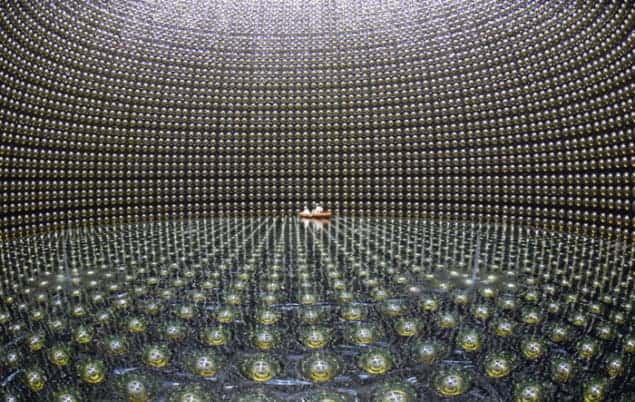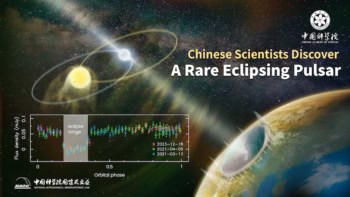
More electron neutrinos from the Sun reach the surface of the Earth during the night than during the day, according to an 18-year study by physicists working with the SuperKamiokande neutrino detector in Japan. The finding offers further confirmation of a prediction made nearly 30 years ago that neutrinos travelling through dense matter change flavour at different rates than neutrinos travelling through empty space. The results also suggest that neutrino detectors of the future could be used to study the interior of the planet.
Electrically neutral and interacting only via the weak force, neutrinos are fiendishly hard to detect – indeed, most neutrinos from the Sun travel straight through the Earth without interacting at all. But several exceptionally sensitive detectors around the world have managed to snare these elusive particles, revealing in the process that neutrinos “oscillate” between different types, or “flavours”, as they travel. In fact, this unusual behaviour explains the long-standing mystery of why far fewer solar neutrinos are captured by electron-neutrino detectors than expected: the electron neutrinos are simply changing into muon and tau neutrinos on their journey to Earth.
At neutrino energies below about 2 MeV, about half of all electron neutrinos from the Sun change flavour before reaching the Earth. For neutrinos of higher energies, however, a larger fraction change, meaning that fewer electron neutrinos are detected. This phenomenon is known as the Mikheyev–Smirnov–Wolfenstein (MSW) effect. In 1986 the Soviet physicists Stanislav Mikheyev and Alexei Smirnov expanded on work carried out in 1978 by the US theorist Lincoln Wolfenstein, who pointed out that the presence of large numbers of electrons in dense objects such as the Sun and the Earth could affect neutrino-oscillation rates.
Reverse oscillation
Physicists working with the SuperKamiokande detector in Japan are now the first to see evidence of the MSW effect on neutrinos that have travelled through the Earth. Buried deep under a mountain about 300 km west of Tokyo, SuperKamiokande detects neutrinos using 50,000 tonnes of water in a cylindrical vessel. The detector incorporates more than 11,000 photomultiplier tubes, which search for the Cerenkov radiation given off by the high-energy electrons or muons that are created when a neutrino interacts with the water.
By looking through years’ worth of data from SuperKamiokande, the team found that the flux of solar neutrinos during the night was about 3.2% greater than that measured during the day. In other words, the Earth has caused muon and tau neutrinos to change back to electron neutrinos, effectively reversing the change that occurred during their journey from the Sun. While the result agrees with the predictions of the MSW effect, the statistical significance is 2.7σ. This is boosted to 2.9σ when the data are combined with a much weaker measurement made by the Sudbury Neutrino Observatory (SNO) in Canada.
Strong indication
Andrew Renshaw of the SuperKamiokande team cautions that the statistical significance is much lower than the 5σ needed for a “discovery” in particle physics and just below the 3σ level that is considered “evidence”. “We tend to claim that this is a strong indication for the MSW effect,” he told physicsworld.com. Because it took 18 years for SuperKamiokande to get to the 2.7σ level, it is likely that data from future neutrino detectors will be needed to take the measurement over 5σ.
The relatively low statistical significance of the results – and the fact that they are broadly in line with other neutrino-oscillation studies – means that the measurements do not represent a significant improvement in our current understanding of neutrino-mixing parameters. However, neutrino expert David Wark of the University of Oxford, who was not involved with the day/night measurement, points out that “neutrino theory is nowhere near as well developed as some other areas of particle physics”. “Every new effect we can observe helps us fill in the puzzle, so it is very interesting any time somebody measures something new,” he adds.
Super goes Hyper
Looking to the future, both Renshaw and Wark believe that it could be possible to use the MSW effect to probe the Earth’s interior. However, Wark says that a detector that could do so would be “a truly vast experiment”, although he adds that HyperKamiokande – the proposed successor to the current detector – has this week been selected by the Science Council of Japan as one of its highest priority new big-science projects.
“HyperKamiokande will be 25 times the size of SuperKamiokande, so we will get a much larger data set,” says Wark. “Whether it would be big enough to make measurements of the Earth’s density with interesting sensitivity, I am not sure, but we will certainly be looking at that as we further develop HyperKamiokande.”
The day/night measurement is described in Physical Review Letters.
- There is much more on neutrino detection and oscillations in this feature-length article by David Wark “Neutrinos: ghosts of matter”



